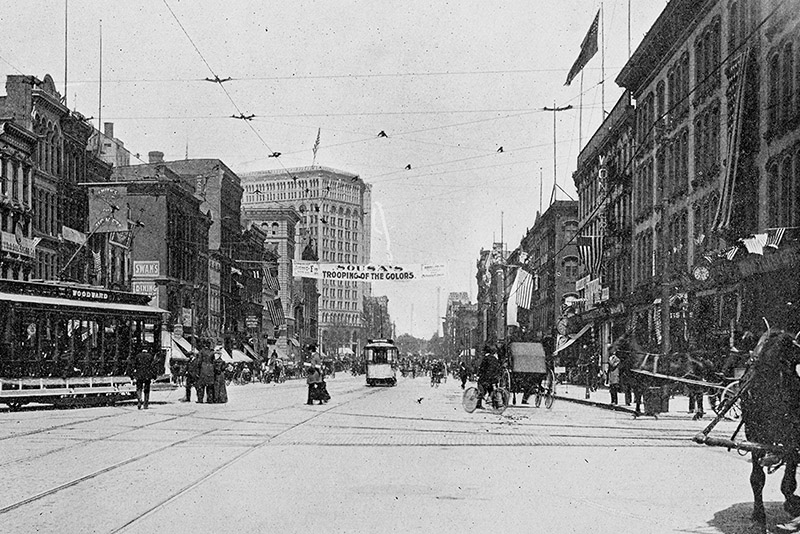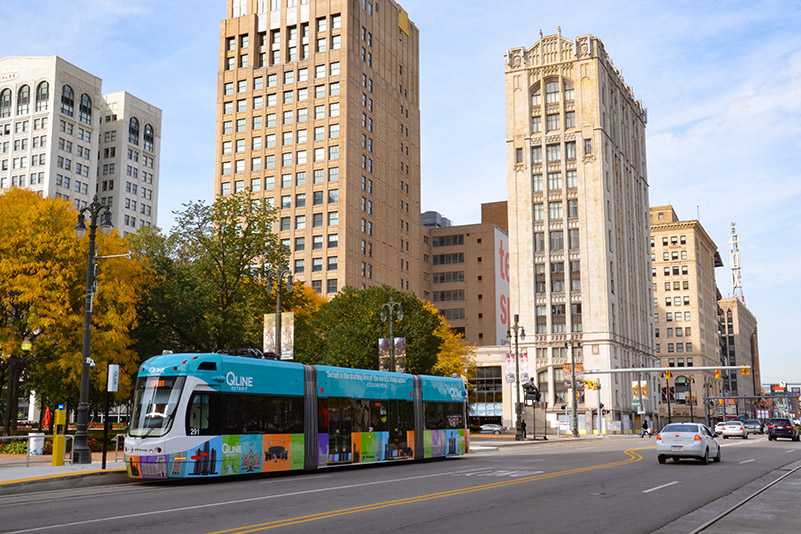Author R.J. King Reflects on Detroit’s Past, Present & Future
by The Vella Group
Detroit author and journalist R.J. King, pictured here, recently held an event at The Vella Group offices to sign copies of his book, Detroit: Engine of America. The event included a thoughtful discussion of Detroit’s colorful past, complex racial history and challenges for the future. Here are R.J.’s answers to some additional questions we posed about the past, present and future of Detroit.
If you could go back in time and alter history, what changes would you make to mitigate Detroit’s decline in the mid-to-late 20th century?
At that time, the city needed a Marshall Plan supported by the federal government. To win World War II, for the first time Detroit shared its mass production techniques with the rest of the country and its Allies. The result was a rapid and massive buildup of tanks, planes, ships, Jeeps, armaments, weapons and munitions. At the same time, Detroit itself geared up for the war, ending the production of cars in 1941 (that’s why there are no cars from model years 1942-45). As existing factories switched to war production, many more plants were built to meet demand for armaments. For example, at Willow Run, Ford Motor Co. built a huge factory that went on to produce more than 8,600 B-24 Liberator bombers — at peak output it was a record of one plane every 55 minutes. But when the war ended, Detroit was left with hundreds of empty factories while at the same it had to return to car production. In turn, the automakers began building plants in other cities to save on transportation costs. What was really needed at the time was a Marshall Plan to level and clean up all of the empty factories following World War II.

Your book shows how Detroit’s grit, determination and ingenuity turned a small French settlement into the Midwest’s first city and eventually, a manufacturing powerhouse. What lessons from the past could help Detroit continue its current economic resurgence?
Go with your strengths. Detroit is one of the few places in the world where nearly anything can be built at scale and at high tolerances. Over the last decade, Detroit has been able to clean up and renovate old industrial sites or build new facilities on the same land. The renovated and new buildings are used for light manufacturing, light assembly, storage and logistics. While global supply chain delays have impacted everyone, more and more manufacturing is returning to the U.S. and Detroit to offset overseas production and shipping delays. That has bolstered Detroit and the region, and brought jobs to the economy, especially in the city. As more manufacturing demand is sought domestically, Michigan has a golden opportunity to set itself up for decades of economic growth.
What has Detroit gotten right about its rebirth/resurgence? Where do you see room for improvement?
For decades, the supply of land outpaced demand in the city. To reduce supply, demand must be created. At 139 square miles, it’s a big city built for 2 million people. Today, there are around 650,000 people living in the city, with more than 4 million people in the suburbs. To get people to return, Detroit has built up an entertainment district that no suburb can come close to matching — historic theaters, sports stadiums, the riverfront and more. The housing stock is being steadily renovated, and new developments have been built. The biggest room for improvement is education. The Detroit Public School Community District has made great strides. Dr. Nikolai Vitti and his team have really improved their outcomes and are making sure students are much better prepared for the next level. Those students are our future workforce — we need to train them well and encourage them to stay once they have graduated from vocational or trade schools, or colleges and universities.
Your book includes a chapter about Seymour Finney who owned a tavern in Detroit in the 1850s, one that often provided lodging to bounty hunters looking for escaped slaves. Yet he was an active abolitionist and supporter of the Underground Railroad. What do you think Seymour would have to say about the state of the Black community in Detroit today?
He would be happy that slavery had ended, but would be dismayed that we are still dealing with racial challenges today. In his time, there were a few Black entrepreneurs, and while there are many more today both here and around the country, most are sole proprietorships. If he were alive today, I believe he would be advocating for more vocational training in high schools to provide for new skill sets complemented with business classes in accounting, finance, operations, marketing, etc. Once those business skills are learned, they never go away. He also would be encouraged by all the nonprofit and charitable organizations that have sprung up to improve community outcomes, but he would wonder why politicians and government departments weren’t doing the job.
Do you think the federal grant awarded to allow Michigan to dismantle I-375 and create a street-level boulevard will be instrumental in reconnecting Detroit communities?
At ground level, there are two communities affected here, Lafayette Park and downtown Detroit. From a regional standpoint, slowing traffic down will limit economic output. People can’t get to work as quickly, emergency vehicles will have a harder time getting around, meaning an extra minute could cost someone their life. While some argue that I-375, when developed by government leaders of the day, was racial in nature in that it affected Black residents more so, the same argument could be made elsewhere. All the freeways have impacted residents no matter their racial standing, including the building of I-375, I-75, I-96, I-94 and the Davison Freeway. They all tore through neighborhoods. Do we eliminate all the freeways and go back to the boulevards? If we did, human lives will be lost due to delays, goods will be more expensive due to higher shipping costs, and pollution will be greater as cars and trucks idle more at traffic stops and lights. Adding more electric vehicles will lead to less air pollution, but it will take decades to get there due to the high costs of owning and operating an EV.
Looking at our transportation system today, MDOT struggles to maintain what it has. And what I’ve seen so far from MDOT for their proposal in making I-375 a boulevard leaves a lot to be desired. It will lead to more congestion, more delays especially among emergency responders and more pollution. It would be better and less expensive, in my opinion, to build over I-375 (and select areas of other freeways) and create new parks and community assets. You have it today at I-696 in Oak Park, with a beautiful park above the freeway. Wherever these freeway parks are built — one is proposed over I-75 at Woodward Avenue to better connect Little Caesars Arena and Midtown to downtown — drivers can still get to their destinations quickly, and residents would have many more amenities and connections.
About R.J. King
R.J. King is editor of DBusiness magazine, DBusiness Daily News, Tech and Mobility News, and Detroit 500, all of which cover companies in metro Detroit and Michigan that are expanding locally, nationally and internationally. Mr. King also is the author of five books — “Grounds for Freedom: Saving Chernobyl,” a silver medal recipient of the Midwest Book Awards; “Detroit: Engine of America,” a gold medal recipient of the Midwest Book Awards; “8 Track: The First Mobile App;” “Passport to the Corner Office: The Starter’s Guide to Corporate Life;” and “Mystical.” Since 2011, DBusiness magazine has been honored with more than 50 Gold, Silver and Bronze medals in the Editorial Excellence Awards from the Alliance of Area Business Publishers, including being named the top regional business magazine in the country. Prior to launching DBusiness in 2006, Mr. King was a business writer for The Detroit News for 16 years, where he wrote more than 4,000 articles covering economic development, automotive, aerospace, health care, technology and more. Mr. King is a board member of Beyond Basics, Detroit Aircraft Corp., Detroit Spacecraft Corp., ASX and the Asian Pacific American Chamber of Commerce. In addition, he serves on the Board of Trustees for The Parade Co. and Detroit Sessions. He is a member of the Detroit Athletic Club, and on the board of the DAC Executives Club and the DAC Car Club. Named a Knight of Woodward, he is a member of the Boston-Edison Historic District and the University of Michigan Alumni Association. In 2014, Mr. King was inducted into the International Heritage Foundation’s Heritage Hall of Fame (youngest recipient).
Photos: Detroit’s Woodward Avenue in the late 19th century and today.
Detroit author and journalist R.J. King, pictured here, recently held an event at The Vella Group offices to sign copies of his book, Detroit: Engine of America. The event included a thoughtful discussion of Detroit’s colorful past, complex racial history and challenges for the future. Here are R.J.’s answers to some additional questions we posed about the past, present and future of Detroit.

If you could go back in time and alter history, what changes would you make to mitigate Detroit’s decline in the mid-to-late 20th century?
At that time, the city needed a Marshall Plan supported by the federal government. To win World War II, for the first time Detroit shared its mass production techniques with the rest of the country and its Allies. The result was a rapid and massive buildup of tanks, planes, ships, Jeeps, armaments, weapons and munitions. At the same time, Detroit itself geared up for the war, ending the production of cars in 1941 (that’s why there are no cars from model years 1942-45). As existing factories switched to war production, many more plants were built to meet demand for armaments. For example, at Willow Run, Ford Motor Co. built a huge factory that went on to produce more than 8,600 B-24 Liberator bombers — at peak output it was a record of one plane every 55 minutes. But when the war ended, Detroit was left with hundreds of empty factories while at the same it had to return to car production. In turn, the automakers began building plants in other cities to save on transportation costs. What was really needed at the time was a Marshall Plan to level and clean up all of the empty factories following World War II.
Your book shows how Detroit’s grit, determination and ingenuity turned a small French settlement into the Midwest’s first city and eventually, a manufacturing powerhouse. What lessons from the past could help Detroit continue its current economic resurgence?
Go with your strengths. Detroit is one of the few places in the world where nearly anything can be built at scale and at high tolerances. Over the last decade, Detroit has been able to clean up and renovate old industrial sites or build new facilities on the same land. The renovated and new buildings are used for light manufacturing, light assembly, storage and logistics. While global supply chain delays have impacted everyone, more and more manufacturing is returning to the U.S. and Detroit to offset overseas production and shipping delays. That has bolstered Detroit and the region, and brought jobs to the economy, especially in the city. As more manufacturing demand is sought domestically, Michigan has a golden opportunity to set itself up for decades of economic growth.
What has Detroit gotten right about its rebirth/resurgence? Where do you see room for improvement?
For decades, the supply of land outpaced demand in the city. To reduce supply, demand must be created. At 139 square miles, it’s a big city built for 2 million people. Today, there are around 650,000 people living in the city, with more than 4 million people in the suburbs. To get people to return, Detroit has built up an entertainment district that no suburb can come close to matching — historic theaters, sports stadiums, the riverfront and more. The housing stock is being steadily renovated, and new developments have been built. The biggest room for improvement is education. The Detroit Public School Community District has made great strides. Dr. Nikolai Vitti and his team have really improved their outcomes and are making sure students are much better prepared for the next level. Those students are our future workforce — we need to train them well and encourage them to stay once they have graduated from vocational or trade schools, or colleges and universities.
Your book includes a chapter about Seymour Finney who owned a tavern in Detroit in the 1850s, one that often provided lodging to bounty hunters looking for escaped slaves. Yet he was an active abolitionist and supporter of the Underground Railroad. What do you think Seymour would have to say about the state of the Black community in Detroit today?
He would be happy that slavery had ended, but would be dismayed that we are still dealing with racial challenges today. In his time, there were a few Black entrepreneurs, and while there are many more today both here and around the country, most are sole proprietorships. If he were alive today, I believe he would be advocating for more vocational training in high schools to provide for new skill sets complemented with business classes in accounting, finance, operations, marketing, etc. Once those business skills are learned, they never go away. He also would be encouraged by all the nonprofit and charitable organizations that have sprung up to improve community outcomes, but he would wonder why politicians and government departments weren’t doing the job.
Do you think the federal grant awarded to allow Michigan to dismantle I-375 and create a street-level boulevard will be instrumental in reconnecting Detroit communities?
At ground level, there are two communities affected here, Lafayette Park and downtown Detroit. From a regional standpoint, slowing traffic down will limit economic output. People can’t get to work as quickly, emergency vehicles will have a harder time getting around, meaning an extra minute could cost someone their life. While some argue that I-375, when developed by government leaders of the day, was racial in nature in that it affected Black residents more so, the same argument could be made elsewhere. All the freeways have impacted residents no matter their racial standing, including the building of I-375, I-75, I-96, I-94 and the Davison Freeway. They all tore through neighborhoods. Do we eliminate all the freeways and go back to the boulevards? If we did, human lives will be lost due to delays, goods will be more expensive due to higher shipping costs, and pollution will be greater as cars and trucks idle more at traffic stops and lights. Adding more electric vehicles will lead to less air pollution, but it will take decades to get there due to the high costs of owning and operating an EV.
Looking at our transportation system today, MDOT struggles to maintain what it has. And what I’ve seen so far from MDOT for their proposal in making I-375 a boulevard leaves a lot to be desired. It will lead to more congestion, more delays especially among emergency responders and more pollution. It would be better and less expensive, in my opinion, to build over I-375 (and select areas of other freeways) and create new parks and community assets. You have it today at I-696 in Oak Park, with a beautiful park above the freeway. Wherever these freeway parks are built — one is proposed over I-75 at Woodward Avenue to better connect Little Caesars Arena and Midtown to downtown — drivers can still get to their destinations quickly, and residents would have many more amenities and connections.
About R.J. King
R.J. King is editor of DBusiness magazine, DBusiness Daily News, Tech and Mobility News, and Detroit 500, all of which cover companies in metro Detroit and Michigan that are expanding locally, nationally and internationally. Mr. King also is the author of five books — “Grounds for Freedom: Saving Chernobyl,” a silver medal recipient of the Midwest Book Awards; “Detroit: Engine of America,” a gold medal recipient of the Midwest Book Awards; “8 Track: The First Mobile App;” “Passport to the Corner Office: The Starter’s Guide to Corporate Life;” and “Mystical.” Since 2011, DBusiness magazine has been honored with more than 50 Gold, Silver and Bronze medals in the Editorial Excellence Awards from the Alliance of Area Business Publishers, including being named the top regional business magazine in the country. Prior to launching DBusiness in 2006, Mr. King was a business writer for The Detroit News for 16 years, where he wrote more than 4,000 articles covering economic development, automotive, aerospace, health care, technology and more. Mr. King is a board member of Beyond Basics, Detroit Aircraft Corp., Detroit Spacecraft Corp., ASX and the Asian Pacific American Chamber of Commerce. In addition, he serves on the Board of Trustees for The Parade Co. and Detroit Sessions. He is a member of the Detroit Athletic Club, and on the board of the DAC Executives Club and the DAC Car Club. Named a Knight of Woodward, he is a member of the Boston-Edison Historic District and the University of Michigan Alumni Association. In 2014, Mr. King was inducted into the International Heritage Foundation’s Heritage Hall of Fame (youngest recipient).
Photos: Detroit’s Woodward Avenue in the late 19th century and today.



